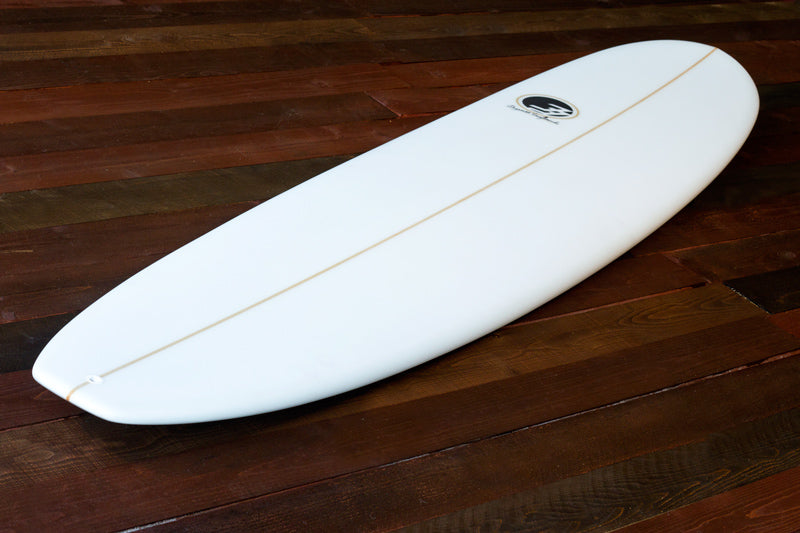Sizing our customers up brings a whole new dimension to surfing. Typically, as a beginner you are forced to buy a surfboard with one primary focus, stability. The bummer about this is even though you are able to stand up... once up, you can hardly turn your board. This forces you to buy another board just to progress and move on (just what you wanted to do... buy 2 boards to learn to surf).
If you did want more maneuverability, you sacrifice float, paddling, and stability, leaving the learning curve super steep and making surfing more difficult than it really is.
HOW DID WE FIX THIS PROBLEM?
We’ve thrown out the idea that each shape caters to a certain style of surfing or surfer. Some companies only make shortboards, some, only longboards. Many shapers take pride in having extremely fine-tuned surfboards for every little application.
Our surfboard lineup is tailored to span all types of surfers. Each board is designed with the widest range of surfers in mind. This means each board will be forgiving while learning, yet will present new doors to open around every corner while you progress.
We’ve taken into account all the elements needed for stability (thickness, width, and concaves), and combined them with the critical elements of maneuverability (rocker, rails, and fin setup). With all the elements working together, you get a board that is stable AND maneuverable. This is EXTREMELY important as a beginner.
Bottom line, as a beginner, you want a surfboard that is both easy to learn and will be a blast to ride as you get better.
Your height and weight directly affect the length and thickness of your surfboard. In general if you are a beginner, THINK BIG.
The reason for this takes us back to the simple dynamics of volume. More volume will float you better, and will feel more stable. This is very important when learning to surf because it allows you to develop technique and balance on a very consistent object.
Keep in mind that as you add length to the board, it’ll be tougher to paddle out through waves. Although your longboard will feel easy to paddle in calm waters, you still need to hold onto it as you go through the waves. If your board is too big for you, you may feel like you are trying to steer a barge, and that is a disaster waiting to happen!
Here are the general rules a beginner should use for length:
Buy a surfboard that is roughly 36” or 3’ taller than the rider. We know this seems huge but you will learn faster and have a lot more fun if you go with a bigger board.
When it comes to thickness, as a beginner, you really won’t have too much to worry about here. Most longboards are in the 2.5” - 3” range and for most surfers under 200lbs that should work great. If you’re in the 200 - 260lbs range will need a little more volume for your surfboard and will likely need a board in the 3” - 3.75” range. (For over 260lbs, you will likely need to order a custom surfboard. For small riders like a grom (youth) read the “Kids” section.)
There are many surfboards out there to choose from... from websites to craigslist to surf shops. Everybody has a board they are trying to sell but most of the boards for sale won’t work for a beginner because of all the reasons we mentioned above.
More than likely you’ll be starting on a longboard. The only question to ask is “which one?”
THE ULTIMATE LONGBOARD

The flagship of Degree33 Surfboards, we decided to call this longboard the “Ultimate” because of its unique ability to combine and utilize so many elements of great longboards into one board. It’s super stable, turns great and takes little effort to paddle. It starts with a flat-to-double concave that allows this longboard to paddle and glide super easy. This is essential to catching waves as you need to match your board speed with the wave speed for easy take offs. The cornerstone, however, is the beveled or “chined” rails that stretch from the nose to just in front of the side fin boxes. The most common “turning error” is digging a rail into the wave, get- ting stuck, and being unable to bring the board around. The chines actually pull the rails up and away from the water allowing for the easiest turns you’ve ever made on a longboard. This board is for EVERYONE.
Here's a review from one of our Ultimate customers:
I just wanted to send you a quick personal response on that Ultimate I picked up from you last weekend. Holy &*$% that board is sweet. I am just learning how to surf and don’t have much experience with other boards (a couple of rentals is all) but that board was so much easier to ride than anything I’ve ever been on.
It paddled great, and I was even able to turn it... I’ve never been able to turn any other surfboard. I am rambling but I am SOO excited and thought you should know. Make sure that any beginner that buys a board from you buys the same one I did. Home run man. Thanks.”
-Chet Womach Lacy, WA (soon to be CA I hope)